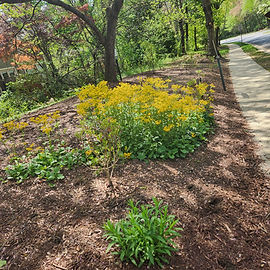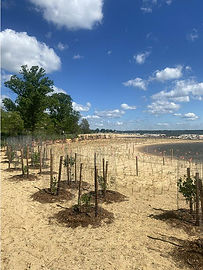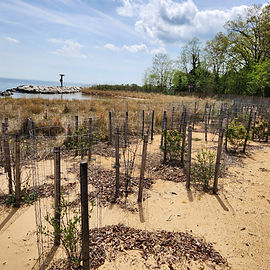Pollinator Pathway
Anne Arundel County (AACO)



The mission of the Anne Arundel County (AACO) Pollinator Pathway, is to Impactfully elevate environmental stewardship of AACO citizens through engagement of households, communities, HOA's, coalitions, local and state government, and unique public-private partnerships. The goal is to create sustainable landscapes throughout AACO that promote climate resilient projects, deliver actionable outcomes of reduced pollution and restored waterways, and bring nature back into our daily lives by focusing on actions people can take right outside their door. Maintaining environmentally-sound gardens and yards by using sustainable gardening practices improves water quality, conserves natural resources for future generations, reduces maintenance, and saves you money.
While individual efforts may seem small, they all add up to make a big difference in improving the health of our local waterways, the Chesapeake Bay, our personal well-being, and the environment. Most Maryland residents live within a half-mile of a drainage ditch, storm drain, stream or river. These local waterways eventually drain into the Chesapeake Bay.
The misuse of pesticides and fertilizers, lack of soil management, and poor plant selection can all contribute to the degradation of Maryland’s streams, rivers, and the Bay. By embracing the change of a few simple landscape practices, together we can keep Maryland communities and pollinators healthy.
Learn more about the Anne Arundel County (AACO) Pollinator Pathway:



Riva Trace Demonstration Garden
Riva Trace Native Planting Erosion Control Demonstration Garden
This garden is a demonstration on how to control soil erosion and prevent sediment from entering storm drains by planting native ground covers and shrubs.



Mayo Beach Park: Shoreline Planting Project
4150 Honeysuckle Dr, Edgewater, MD 21037
In 2024 Mayo Beach Park completed a shoreline restoration project to maintain the sandy beaches that make the beach park a sought after swimming location; however, a portion of the shoreline project included creating a living shoreline where there once was a swimming beach. This area was at the southern most end of the beach. It sustained most wave action and erosion as the park is at the mouth of the South River along the Chesapeake Bay. It also left a platform for nesting Osprey exposed to human interaction from beach goers. To protect the Osprey and prevent further erosion, the Park Superintendent decided to turn this section into a living shoreline.
To create the shoreline, the gap between the two rocky barriers that let in water to the shoreline was reduced and native grasses, along with native bay berry bushes were planted in the sandy horseshoe shape that the rock barriers created. A fence was put up to protect the grasses, reduce movement of sand, and define the space. One year after planting, the shoreline is in excellent condition and the nesting Osprey were more than happy to find a secluded location to raise their young after their long migration from the south.



Mayo Beach Park: Pollinator Plots
4150 Honeysuckle Dr, Edgewater, MD 21037
Mayo Beach Park is predominantly a swimming beach. But back before the county
owned the land, it was a hopping private recreational swimming area, with baseball fields, a large playground, concession stands, and areas to grill a delicious meal. When Anne Arundel County Recreation and Parks purchased the land, the vision changed and the ball fields became simply mowed fields that were, maybe occasionally, used for overflow parking. In an effort to add habitat and reduce the amount of mowing, AACO Recreation and Park Superintendent Karen Jarboe, decided to turn the field into pollinator plots that would serve as spaces for environmental education, interpretation opportunities for rangers, and beautiful spaces for beach goers to connect with nature beyond the beach.
The project was initially coordinated through a grant for Anne Arundel County’s Green
Infrastructure. Jonas Lai, who was the green infrastructure liaison, and Superintendent Jarboe worked together to create a vision for the space. He then partnered with Lauren Toomey of RePollinate Anne Arundel and the USGS Native Bee Lab who shared their unique planting methods, which were utilized on site. This included creating a perimeter of mulch to plant mature plants, leaving the inside of the plot to be tilled and seeded with a native pollinator mix. The idea is that the mature plants will disseminate their seeds into the interior of the plot, naturally creating more diversity as the plots mature.
The project has been overwhelmingly successful and needs little maintenance from year
to year. There are more plots to be created. The park will maintain the same methods; however, volunteers from other organizations such as the Arundel River Federation, Scouts of America, and the Chesapeake Conservation and Climate Corps have and will continue to donate plants, materials, and people hours.
To join: Click on the link below to view the steps you can take to make an impactful contribution to pollinator health, the environment, and our individual well-being.
Email us at Annearundelcounty@pollinator-pathway.org or friend us on Facebook or Instagram
Partners
The AACO Pollinator Pathway is an initiative endorsed by Sam Droege, Wildlife Biologist, Native Bee and Monitoring Program, USGS Patuxent Wildlife Research Center; Crofton Village Garden Club (CVGC); AACO Watershed Stewards Academy; Bay-Wise in AACO; AACO Master Gardeners; and AACO Master Naturalists.



